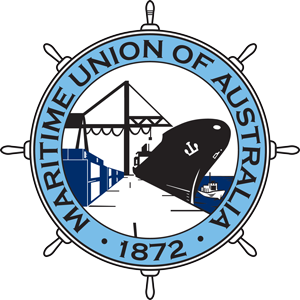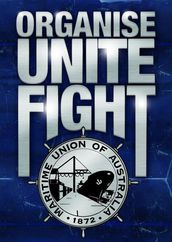 The Seaman's Union of Australia and Waterside Workers Federation merge to create the Maritime Union of Australia (1993). Thelead-up to the merger saw the Marine Cooks Bakers and Butchers Association (formed in 1908) amalgamated with the SUA in 1983, and the Federated Marine Stewards and Pantrymen's Association merged in 1988. In 1991 the Professional Divers Association also amalgamated with the S.U.A.
The Seaman's Union of Australia and Waterside Workers Federation merge to create the Maritime Union of Australia (1993). Thelead-up to the merger saw the Marine Cooks Bakers and Butchers Association (formed in 1908) amalgamated with the SUA in 1983, and the Federated Marine Stewards and Pantrymen's Association merged in 1988. In 1991 the Professional Divers Association also amalgamated with the S.U.A.
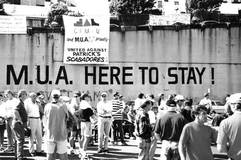 Patrick Corporation CEO Chris Corrigan undertakes an illegal restructuring of operations for the claimed purpose of increasing theproductivity of the workforce and locks out MUA members in April 1998, sparking an 80-day dispute that galvanizes the entire labour movement. MUA wins critical litigation and members return to their jobs when Justice Tony North orders the reinstatement of rights for the workers, saying in his legal ruling that, "By dividing the functions of employing workers and owning the business between two companies, the Patrick group put in place a structure which made it easier for it to dismiss the whole workforce. It is arguable on the evidence that this was done because the employees were members of the union."
Patrick Corporation CEO Chris Corrigan undertakes an illegal restructuring of operations for the claimed purpose of increasing theproductivity of the workforce and locks out MUA members in April 1998, sparking an 80-day dispute that galvanizes the entire labour movement. MUA wins critical litigation and members return to their jobs when Justice Tony North orders the reinstatement of rights for the workers, saying in his legal ruling that, "By dividing the functions of employing workers and owning the business between two companies, the Patrick group put in place a structure which made it easier for it to dismiss the whole workforce. It is arguable on the evidence that this was done because the employees were members of the union."
 Starting in 2005, the MUA plays a central role in the labour-wide "Your Rights at Work" campaign to defeat the Howard Government'santi-union Work Choices. In one day, the 15th of November 2005, a national day of protest brings over half a million people to marches and protests in Australia's state capitals and other cities. A year later, on 30th November 2006, another national day of protest, with rallies or meetings in about 300 sites nationwide, bring out tens of thousands including for the Melbourne crowd ranged from 45,000 to 65,000 people in Melbourne, 40,000 in Sydney, and 20,000 in Brisbane.The campaign is central to the defeat of the Conservative government in the 2007 elections.
Starting in 2005, the MUA plays a central role in the labour-wide "Your Rights at Work" campaign to defeat the Howard Government'santi-union Work Choices. In one day, the 15th of November 2005, a national day of protest brings over half a million people to marches and protests in Australia's state capitals and other cities. A year later, on 30th November 2006, another national day of protest, with rallies or meetings in about 300 sites nationwide, bring out tens of thousands including for the Melbourne crowd ranged from 45,000 to 65,000 people in Melbourne, 40,000 in Sydney, and 20,000 in Brisbane.The campaign is central to the defeat of the Conservative government in the 2007 elections.
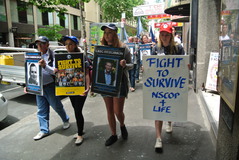 Thousands participate in rallies and actions as the MUA embarks on a country-wide campaign to enact the first-ever national safety code(NSCOP). Fathers,mums, sisters, brothers created a chorus of the vast majority of Australians who were pitted against a small collection of stevedoring companies and their corporate allies. For maritime workers, the code is a fight for survival. But, the campaign is also supported by workers in every industry because the code represents basic Australian values: life before profits, societal well-being before individual gain.
Thousands participate in rallies and actions as the MUA embarks on a country-wide campaign to enact the first-ever national safety code(NSCOP). Fathers,mums, sisters, brothers created a chorus of the vast majority of Australians who were pitted against a small collection of stevedoring companies and their corporate allies. For maritime workers, the code is a fight for survival. But, the campaign is also supported by workers in every industry because the code represents basic Australian values: life before profits, societal well-being before individual gain.
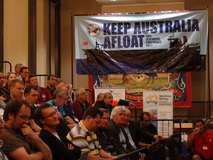 The MUA champions major shipping reform legislation that passed in June 2012, hailing a simplified three-tier licensing framework forparticipation in the coastal trade and restoring fair cabotage; establishing a genuine national flag through the Australian International Shipping Register, putting Australian companies on a level footing with international competitors; establishing a Maritime Workforce Development Forum to progress key maritime skills and training priorities; and a zero corporate tax rate similar to the European tonnage tax systems to remove barriers to investment in Australian shipping and to foster the global competitiveness of the shipping industry.
The MUA champions major shipping reform legislation that passed in June 2012, hailing a simplified three-tier licensing framework forparticipation in the coastal trade and restoring fair cabotage; establishing a genuine national flag through the Australian International Shipping Register, putting Australian companies on a level footing with international competitors; establishing a Maritime Workforce Development Forum to progress key maritime skills and training priorities; and a zero corporate tax rate similar to the European tonnage tax systems to remove barriers to investment in Australian shipping and to foster the global competitiveness of the shipping industry.

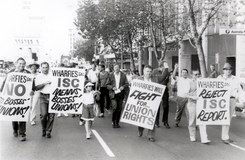 After one hundreds years of existence, the maritime workers' unions are firmly established as important components of the labour movement. In 1973, the SUA creates the SeafarersRetirement Fund (SRF), which starts as a $1-plus contribution with a $6 benefit payout - a significant step in ensuring the dignity of seafarers in their golden years and establishing superannuation as a bedrock principle. A 1974 strike by the WFF leads to substantial wage gains, as the union begins to grapple with containerisation and contemplates the notion of an industry wide union for stevedoring and the entire maritime workforce.
After one hundreds years of existence, the maritime workers' unions are firmly established as important components of the labour movement. In 1973, the SUA creates the SeafarersRetirement Fund (SRF), which starts as a $1-plus contribution with a $6 benefit payout - a significant step in ensuring the dignity of seafarers in their golden years and establishing superannuation as a bedrock principle. A 1974 strike by the WFF leads to substantial wage gains, as the union begins to grapple with containerisation and contemplates the notion of an industry wide union for stevedoring and the entire maritime workforce. The price and income accords of the Labor Hawke Government are put in place. Unions agreed to hold down wage demands and, in return, the government pledged tominimise inflation. Supportersof the accords point to increased spending on families, child care and the creation of Medicare, while critics say the deal kept wages stagnant for a decade and undermined the broader fight for the Australian working class by imposing wage constraints and rigid bargaining frameworks.
The price and income accords of the Labor Hawke Government are put in place. Unions agreed to hold down wage demands and, in return, the government pledged tominimise inflation. Supportersof the accords point to increased spending on families, child care and the creation of Medicare, while critics say the deal kept wages stagnant for a decade and undermined the broader fight for the Australian working class by imposing wage constraints and rigid bargaining frameworks.
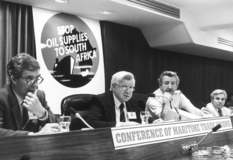 Maritime workers engage globally to end the racist apartheid regime in South Africa, including a 1976 waterfront ban on South African cargo to protest the killings in Soweto. The SUAplays a key role in enforcing the oil boycott against South Africa. Nelson Mandela later states that the oil boycott was a significant factor in toppling the apartheid regime because it denied the military and police easy access to fuel needed to power the brutal instruments of terror used against the people.
Maritime workers engage globally to end the racist apartheid regime in South Africa, including a 1976 waterfront ban on South African cargo to protest the killings in Soweto. The SUAplays a key role in enforcing the oil boycott against South Africa. Nelson Mandela later states that the oil boycott was a significant factor in toppling the apartheid regime because it denied the military and police easy access to fuel needed to power the brutal instruments of terror used against the people.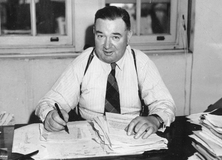 James "Big Jim" Healy modernises the WWF, rising in 1937 to be its general secretary. He is the first editor of the WWF's journal, the Maritime Worker. He joins the Communist Party and is a committed internationalist, campaigning in support of waterside workers' boycotts of Japan and a boycott of Dutch ships from 1945-1949 as a way to bolster the Indonesian independence movement.
James "Big Jim" Healy modernises the WWF, rising in 1937 to be its general secretary. He is the first editor of the WWF's journal, the Maritime Worker. He joins the Communist Party and is a committed internationalist, campaigning in support of waterside workers' boycotts of Japan and a boycott of Dutch ships from 1945-1949 as a way to bolster the Indonesian independence movement.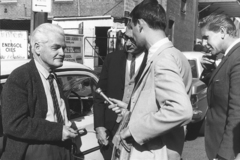 .V. Eliot becomes SUA national secretary, leading the union for almost four decades, instilling the culture of rank-and-file involvement and embracing the vision that while seamen had "to take advantage of technological developments", at the same time, "men are more important than machines and new ships." He also takes the union into many national and international campaigns, including advocating for Aboriginal rights, opposing apartheid in South Africa, opposing the Vietnam War, and participating in the nuclear disarmament movement.
.V. Eliot becomes SUA national secretary, leading the union for almost four decades, instilling the culture of rank-and-file involvement and embracing the vision that while seamen had "to take advantage of technological developments", at the same time, "men are more important than machines and new ships." He also takes the union into many national and international campaigns, including advocating for Aboriginal rights, opposing apartheid in South Africa, opposing the Vietnam War, and participating in the nuclear disarmament movement.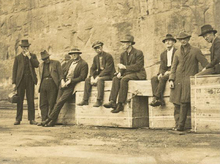
 In November 1938, Port Kembla wharfies refuse to load pig iron on to the Dalfram, a boat bound for Japan. It is a courageous action, joining worldwide work stoppages to stop the flow ofiron and other war supplies to Japan in the years leading up to World War II. Wharfies fear that the pig iron will end up in bombs dropped on Australia, as well as instruments of war against China and other nations. By threating to bring in scab labour, Attorney General R. G. Menzies earns the historic label, "Pig Iron Bob". Ultimately, the Dalfram is loaded but future pig iron shipments cease from the Port.
In November 1938, Port Kembla wharfies refuse to load pig iron on to the Dalfram, a boat bound for Japan. It is a courageous action, joining worldwide work stoppages to stop the flow ofiron and other war supplies to Japan in the years leading up to World War II. Wharfies fear that the pig iron will end up in bombs dropped on Australia, as well as instruments of war against China and other nations. By threating to bring in scab labour, Attorney General R. G. Menzies earns the historic label, "Pig Iron Bob". Ultimately, the Dalfram is loaded but future pig iron shipments cease from the Port. The Sydney Wharf Labourers Union was established in 1872, eventually leading to formation of the Waterside Workers Federation in 1902. In 1906, several unions came together toform the Seamen's Union of Australia. During this period, the world witnessed great maritime strikes, especially in England and Australia, which would set the stage for internationalism and class struggle.
The Sydney Wharf Labourers Union was established in 1872, eventually leading to formation of the Waterside Workers Federation in 1902. In 1906, several unions came together toform the Seamen's Union of Australia. During this period, the world witnessed great maritime strikes, especially in England and Australia, which would set the stage for internationalism and class struggle.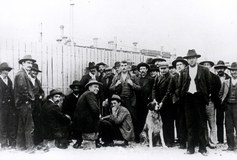 World War I heralded an intense three years. In 1914, the Commonwealth handed down a critical award, setting increased ages, overtime rates, payments for meal and smoko times, and,as important, safety requirements relating to weights and temperature limits. The maritime workers community was also embroiled in opposing a wartime-conscription campaign, which eventually would lead to the ejection from the union of Prime Minister Billy Hughes, who was also serving as the president of the WWF. In 1917, a nationwide strike erupted, lasting almost four months, with wharf labourers joining tens of thousands of other workers to protest low wages, high inflation, war profiteering and a general anti-union, conservative politics.
World War I heralded an intense three years. In 1914, the Commonwealth handed down a critical award, setting increased ages, overtime rates, payments for meal and smoko times, and,as important, safety requirements relating to weights and temperature limits. The maritime workers community was also embroiled in opposing a wartime-conscription campaign, which eventually would lead to the ejection from the union of Prime Minister Billy Hughes, who was also serving as the president of the WWF. In 1917, a nationwide strike erupted, lasting almost four months, with wharf labourers joining tens of thousands of other workers to protest low wages, high inflation, war profiteering and a general anti-union, conservative politics.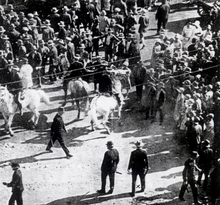 The infamous Transport Workers Act or 'Dog Collar Act', is championed by Prime Minister Stanley Bruce, whose government relentlessly attacked workers and their unions. The Dog Collar Act forced Wharfies to hold a special license to work. The license cost one shilling per year and, without one, waterside workers could not work. During mass demonstrations across the country in November 1928, Allan Prior Whittaker is shot through the back of the neck by police, and later dies, at Princes Pier Port Melbourne. Bruce was defeated in the next election, in 1929, paving the way for a more pro-worker Labor government just as the Great Depression loomed.
The infamous Transport Workers Act or 'Dog Collar Act', is championed by Prime Minister Stanley Bruce, whose government relentlessly attacked workers and their unions. The Dog Collar Act forced Wharfies to hold a special license to work. The license cost one shilling per year and, without one, waterside workers could not work. During mass demonstrations across the country in November 1928, Allan Prior Whittaker is shot through the back of the neck by police, and later dies, at Princes Pier Port Melbourne. Bruce was defeated in the next election, in 1929, paving the way for a more pro-worker Labor government just as the Great Depression loomed.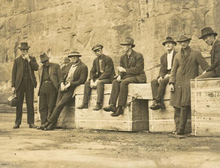 The 1929 Depression hits maritime workers hard. Thousands of maritime workers could not find work, and membership in the WWF dropped by half. The Hungry Mile, the area at DarlingHarbour in Sydney, teemed with maritime workers walking from wharf to wharf looking for work.
The 1929 Depression hits maritime workers hard. Thousands of maritime workers could not find work, and membership in the WWF dropped by half. The Hungry Mile, the area at DarlingHarbour in Sydney, teemed with maritime workers walking from wharf to wharf looking for work.